It looks like you're using an Ad Blocker.
Please white-list or disable AboveTopSecret.com in your ad-blocking tool.
Thank you.
Some features of ATS will be disabled while you continue to use an ad-blocker.
share:
This is so cool! The dark patches are coming in to focus and they really look like an ocean of some kind to me. Could it be similar to the liquid
methane sea on Titan?
a reply to: smitastrophe
It does seem as if the "Whale Tail" flows into a river system of some kind.....
I like my mysterious celestial objects to be dark and forbidding....
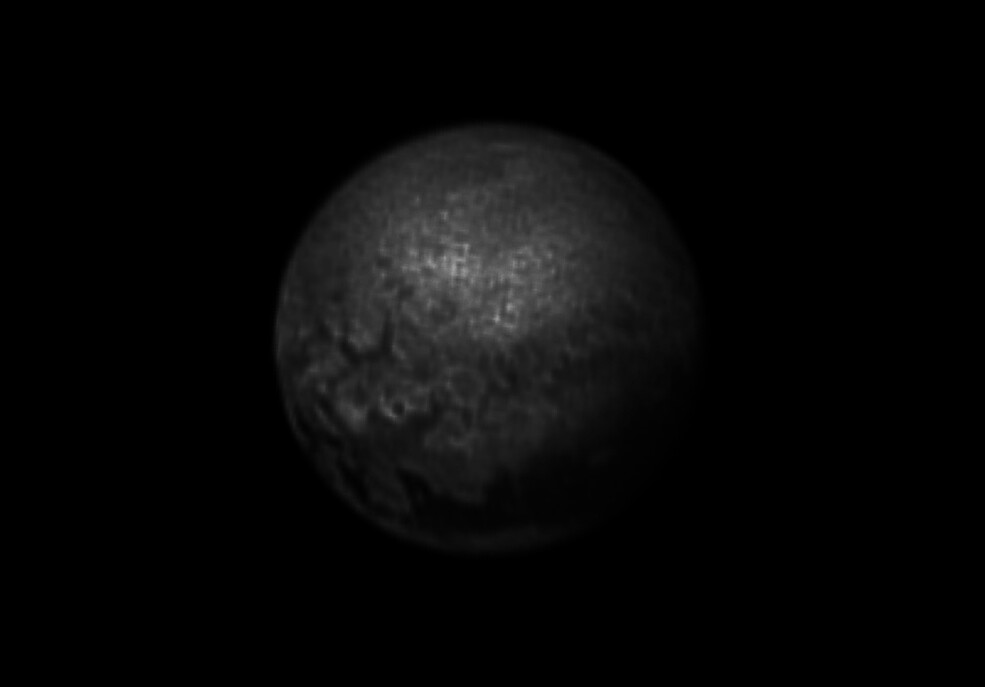
It does seem as if the "Whale Tail" flows into a river system of some kind.....
I like my mysterious celestial objects to be dark and forbidding....

a reply to: Kapusta
One more week! I can't wait:
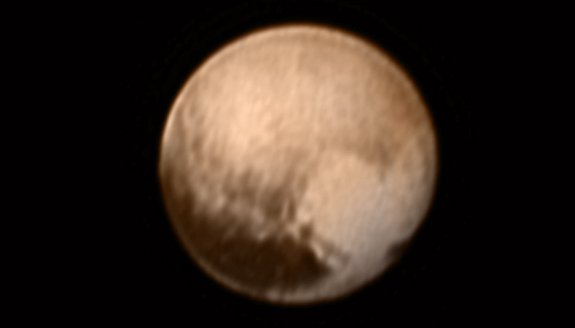
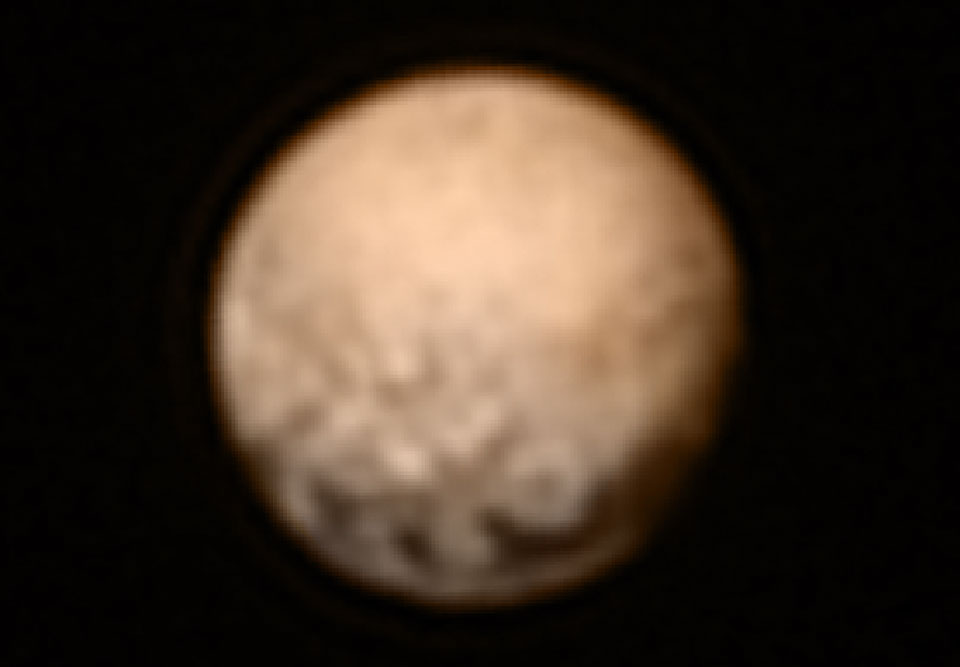
Courtesy of NASA. There is one image of Charon I saw earlier but I can't find it anymore. It also has some interesting features.
One more to add. The moon Charon:
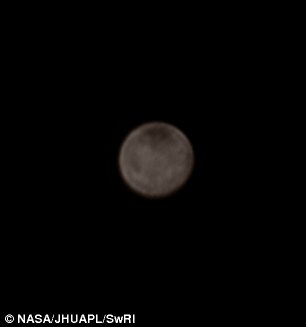
One more week! I can't wait:


Courtesy of NASA. There is one image of Charon I saw earlier but I can't find it anymore. It also has some interesting features.
edit on KSat, 11 Jul 2015 00:52:14 -0500am3120151440 by Kratos40 because: spelling
One more to add. The moon Charon:

edit on KSat, 11 Jul 2015 00:59:58 -0500am3120155840 by Kratos40 because: added Charon
originally posted by: wildespace
originally posted by: xxThothxx
Wild speculation here, but I wonder if those darkest areas are clouds, and the lighter area is an ocean of methane or neon?
Pluto's gravity and atmosphere aren't sufficien for such features. It's too cold there for liquid gasses, they either freeze solid or sublimate into gas. The lighter areas are most probably frozen gasses, and darker areas are hydrocarbon "muck", similar to the dark dunes on Titan.
Ya googling I can't find any support for it. If there were any possbility of lakes of something I should have found at least some hits. For example, they knew Titan had lakes what in the 70's? And what could possibly be liquid at that temperature? It can't be methane because pluto is too cold.
If theyr'e lakes they're frozen lakes. I wonder if any of those features were caused by crovolcanic activity?
Probably some weird geology thing.
Compared to Ceres, it's so far very ineresting. At least with this dwarf planet we have something like "weather". But they've known for a long time Pluto is more complicated than many of us gave it credit,
edit on 11-7-2015 by jonnywhite because: (no reason given)
originally posted by: jonnywhite
originally posted by: wildespace
originally posted by: xxThothxx
Wild speculation here, but I wonder if those darkest areas are clouds, and the lighter area is an ocean of methane or neon?
Pluto's gravity and atmosphere aren't sufficien for such features. It's too cold there for liquid gasses, they either freeze solid or sublimate into gas. The lighter areas are most probably frozen gasses, and darker areas are hydrocarbon "muck", similar to the dark dunes on Titan.
Ya googling I can't find any support for it. If there were any possbility of lakes of something I should have found at least some hits. For example, they knew Titan had lakes what in the 70's? And what could possibly be liquid at that temperature? It can't be methane because pluto is too cold.
That's what I said, the dark and light features on Pluto are solid (as far as we know), i.e. frozen methane "ice" and dark hydrocarbon "muck" formed by the cosmic particle bombardment.
Hydrocarbon "seas" on Titan are confined to the north pole. The vast dark areas around the equatorial regions are solid hydrocarbons. www.space.com...
edit on 11-7-2015 by wildespace because: (no
reason given)
A series of the latest LORRI images, enlarged and enhanced by me:
July 7th
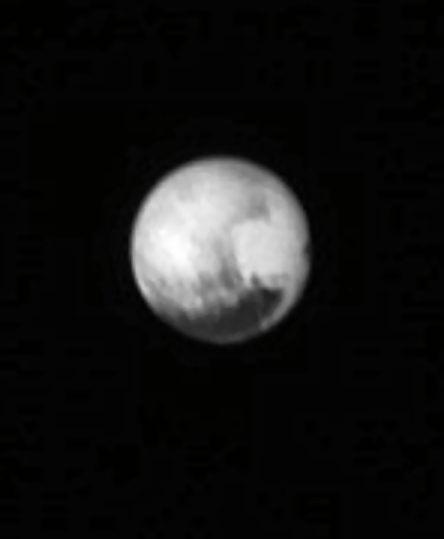
July 9th (4:23 UTC)
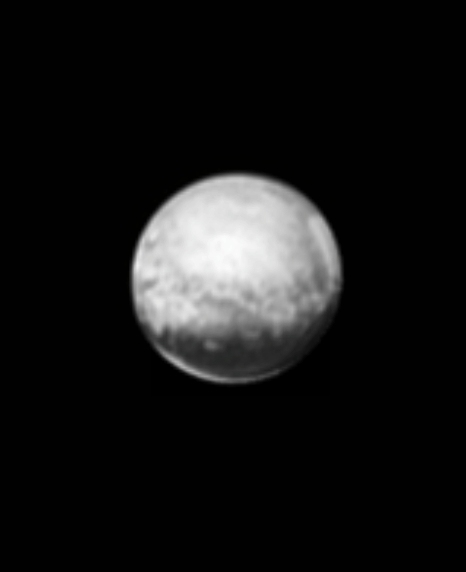
July 9th (22:37 UTC)
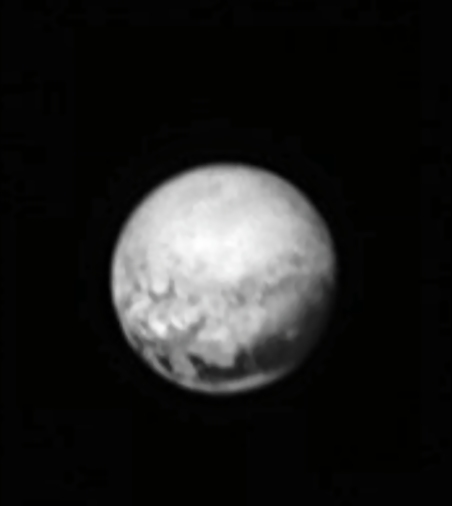
The last image is the latest one so far, but I think the mission control have the subsequent images where those mysteriois dark spots are fully in the view, and they're giving themselves time to examine them.
July 7th

July 9th (4:23 UTC)

July 9th (22:37 UTC)

The last image is the latest one so far, but I think the mission control have the subsequent images where those mysteriois dark spots are fully in the view, and they're giving themselves time to examine them.
Can somebody give me alink of the most up-to-date photos being taken? furthermore... when will the clearest images show?
originally posted by: combatmaster
Can somebody give me alink of the most up-to-date photos being taken? furthermore... when will the clearest images show?
This is a link that can be found on New Horizon Mission website. These are the images from the LORRI camera (LOng Range Reconnaissance Imager)
New Horizons -- LORRI Images
That page is updated regularly (sometimes daily) with images from LORRI. A note on the link describes the timing of the posting of images and how quickly the images are posted after being taken:
Welcome to the New Horizons image site, where NASA and the New Horizons mission are happy to provide these JPEG images - displayed in raw form without special processing - for the public to use and enjoy. These JPEGs of images taken by the LOng Range Reconnaissance Imager (LORRI) are generally posted within 48 hours after receipt at the New Horizons Science Operations Center. The date/time listed in the image caption is when the picture was taken by the spacecraft, though receipt of the data on Earth could be many days later, depending on when the image is downloaded from New Horizons.
I'm not sure when the best images will be available, but New Horizons has its closest approach on Tuesday July 14 at 11:49:57 UTC
Here is a link to the new Horizons website, which is run by Johns Hopkins Applied Physics Laboratory. They are the principle investigator on this mission for NASA.
New Horizons Mission Website
originally posted by: Soylent Green Is People
originally posted by: combatmaster
Can somebody give me alink of the most up-to-date photos being taken? furthermore... when will the clearest images show?
This is a link that can be found on New Horizon Mission website. These are the images from the LORRI camera (LOng Range Reconnaissance Imager)
New Horizons -- LORRI Images
Sometimes, newest images (or rather processed versions of them) appear at NASA's "blog" before they are uploaded to the LORRI camera page: www.nasa.gov...
This has been the case for the latest two image series.
originally posted by: egidio88
3.bp.blogspot.com...
what the actual f**k?
That is the question New Horizons is set to answer in the coming days.
This is the last look at the "mysterious spots" we get, because the spacecraft will see a different side of Pluto as it makes the flyby in a couple of days' time: www.nasa.gov...
Three billion miles from Earth and just two and a half million miles from Pluto, NASA’s New Horizons spacecraft has taken its best image of four dark spots that continue to captivate.
The spots appear on the side of Pluto that always faces its largest moon, Charon—the face that will be invisible to New Horizons when the spacecraft makes its close flyby the morning of July 14. New Horizons principal investigator Alan Stern of the Southwest Research Institute, Boulder, Colorado, describes this image as “the last, best look that anyone will have of Pluto’s far side for decades to come.”
The spots are connected to a dark belt that circles Pluto’s equatorial region. What continues to pique the interest of scientists is their similar size and even spacing. “It’s weird that they’re spaced so regularly,” says New Horizons program scientist Curt Niebur at NASA Headquarters in Washington. Jeff Moore of NASA’s Ames Research Center, Mountain View, California, is equally intrigued. “We can’t tell whether they’re plateaus or plains, or whether they’re brightness variations on a completely smooth surface.”
The large dark areas are now estimated to be 300 miles (480 kilometers) across, an area roughly the size of the state of Missouri. In comparison with earlier images, we now see that the dark areas are more complex than they initially appeared, while the boundaries between the dark and bright terrains are irregular and sharply defined.
Pluto now looks big enough in the images to look good without enlarging and enhancing:
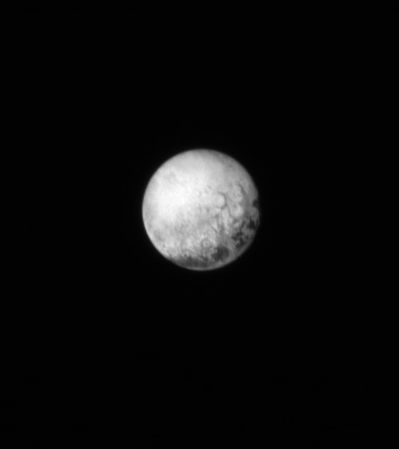
But here's my enlarged and slightly enhanced version anyway:
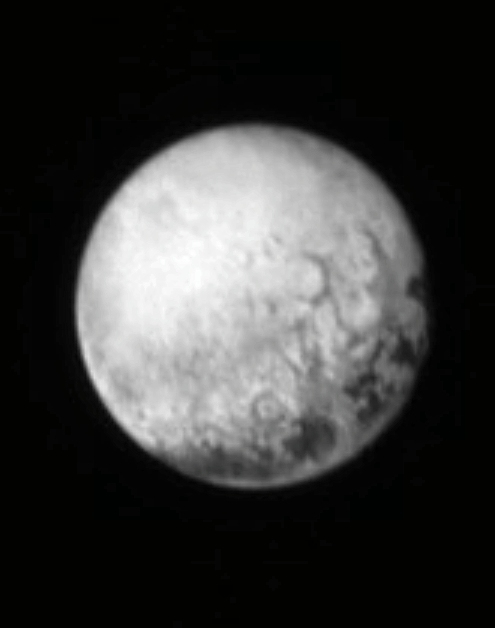
originally posted by: JimOberg
Here's my perspective -- spectrum.ieee.org...
Well worth the read, thanks for the link and the thoughts. I'd really like to read a thread by you on the advances of the 1880's, which seems, in many ways, a very dynamic decade in human history. Thanks again.
Thinking back all those years ago when I was wee child starting school (say 25 years ago) and they were teaching us about the solar system. Pluto was
still classified as a planet, nobody had ever laid eyes on it (aside from grainy telescopic dots) and its characteristics were all left to the
imagination. With the help of the Horizon project I'm starting to believe that Pluto is the most beautiful and mysterious planet I have ever seen.
With the newly released photos we can finally see how incredible the surface of this 'planet' actually is. Can we start a petition to (re)classify it
as a planet? I think it deserves this status.
The press briefing with the latest results is now live in session: time.com...
and there are some juicy images to share. I'm watching it as it unfolds, and the first high-rez image they've shown is Pluto's moon Charon:

Wow!
I'll upload more images as they are broadcast.
[Edit] The first detailed close-up image of Pluto (area near the bottom of the "heart")
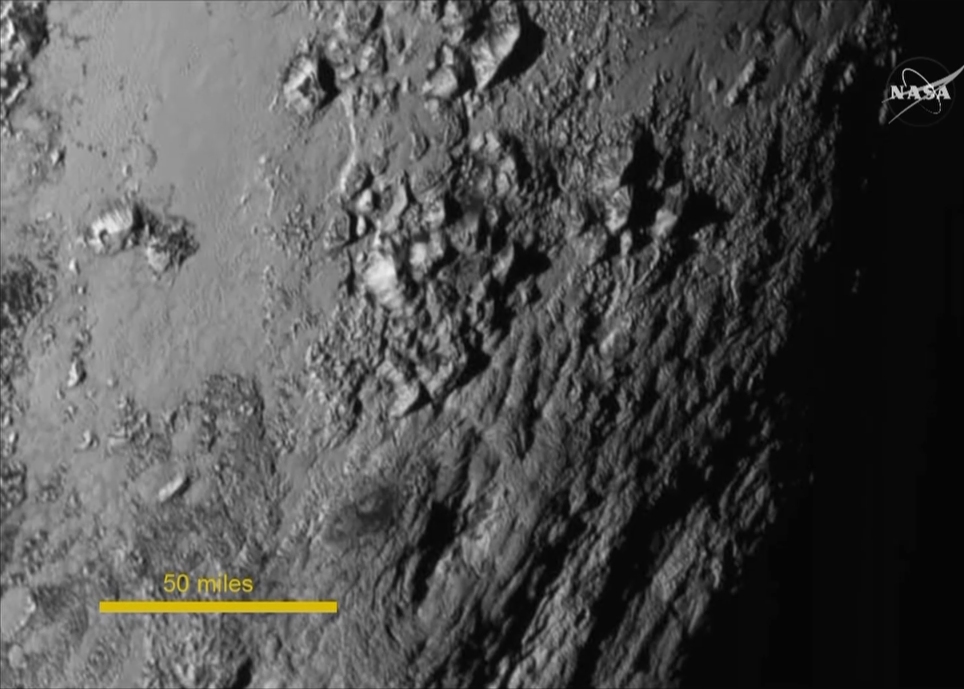
The moon Hydra looks pecular indeed:
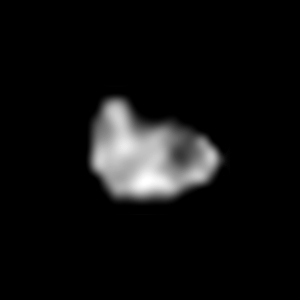
and there are some juicy images to share. I'm watching it as it unfolds, and the first high-rez image they've shown is Pluto's moon Charon:

Wow!
I'll upload more images as they are broadcast.
[Edit] The first detailed close-up image of Pluto (area near the bottom of the "heart")

The moon Hydra looks pecular indeed:

edit on 15-7-2015 by wildespace because: (no reason given)
Dr Brian May (of the Queen fame) posted this incredible high(ish)-rez image of Pluto from the data that came down on July 17th.
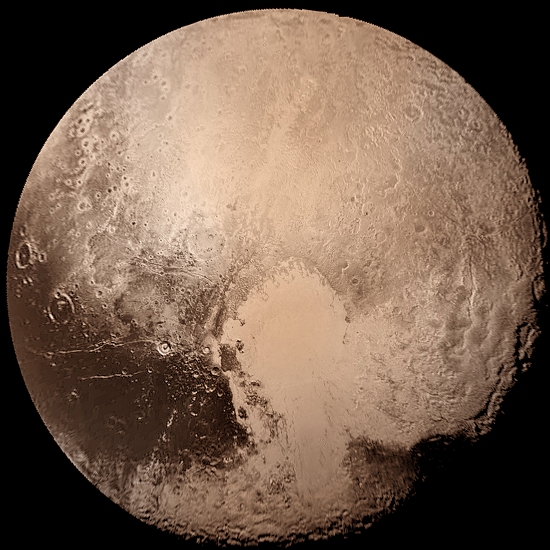
It's a 2-by-2 LORRI mosaic, colourised with data from Ralph camera.
Original (huge) image: s14.postimg.org...
Brian used this and the "last look" image from July 15th to create a stereo pair: www.brianmay.com...
Source: www.brianmay.com...
[Edit] The original image posted by Brian May has been removed, so the link I provided is from someone who reuploaded it while it was still available. Perhaps the NH team want to release a cleaner version, as some stitching artifacts are visible.

It's a 2-by-2 LORRI mosaic, colourised with data from Ralph camera.
Original (huge) image: s14.postimg.org...
Brian used this and the "last look" image from July 15th to create a stereo pair: www.brianmay.com...
Source: www.brianmay.com...
[Edit] The original image posted by Brian May has been removed, so the link I provided is from someone who reuploaded it while it was still available. Perhaps the NH team want to release a cleaner version, as some stitching artifacts are visible.
edit on 21-7-2015 by wildespace because: (no
reason given)
new topics
-
Everything Falls…
Philosophy and Metaphysics: 34 minutes ago -
Steering the Titantic from the Drydock.
US Political Madness: 3 hours ago
top topics
-
House Passes Laken Riley Act
Mainstream News: 15 hours ago, 23 flags -
What Comes After January 20th
Mainstream News: 17 hours ago, 18 flags -
Hearing more ambulances lately
Medical Issues & Conspiracies: 14 hours ago, 7 flags -
Los Angeles brush fires latest: 2 blazes threaten structures, prompt evacuations
Mainstream News: 14 hours ago, 7 flags -
Steering the Titantic from the Drydock.
US Political Madness: 3 hours ago, 6 flags -
Paramilitary Leaks - John Williams
Whistle Blowers and Leaked Documents: 12 hours ago, 6 flags -
Canada as a state .. how would it work?
General Chit Chat: 17 hours ago, 4 flags -
The more I think about it
General Chit Chat: 15 hours ago, 4 flags -
Some sausage, some chicken, some sauce, some onions and some garlic...and some peppers!
Food and Cooking: 14 hours ago, 3 flags -
Everything Falls…
Philosophy and Metaphysics: 34 minutes ago, 0 flags
active topics
-
Post A Funny (T&C Friendly) Pic Part IV: The LOL awakens!
General Chit Chat • 8001 • : baddmove -
Steering the Titantic from the Drydock.
US Political Madness • 8 • : fringeofthefringe -
The more I think about it
General Chit Chat • 6 • : chiefsmom -
ILLUMINATION: Dimensions / Degrees – Da Vincis Last Supper And The Philosophers Stone
Secret Societies • 22 • : CarlLaFong -
Remember These Attacks When President Trump 2.0 Retribution-Justice Commences.
2024 Elections • 139 • : Oldcarpy2 -
Canada as a state .. how would it work?
General Chit Chat • 19 • : Freeborn -
Everything Falls…
Philosophy and Metaphysics • 0 • : JJproductions -
Let's Buy Greenland
General Chit Chat • 18 • : CriticalStinker -
Meta Llama local AI system is scary good
Science & Technology • 50 • : ArMaP -
Gravitic Propulsion--What IF the US and China Really Have it?
General Conspiracies • 35 • : bastion
